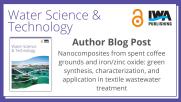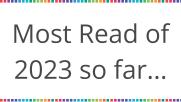 IWAP Open Access Ambassadors: Spotlight Blog #28
IWAP Open Access Ambassadors: Spotlight Blog #28
A new Open Access Ambassador Spotlight Blog from Kator Jethro Ifyalem. He looks at the mental health impacts of access to clean and safe water.
 Author Blog Post - Water Science and Technology
Author Blog Post - Water Science and Technology
A new blog post from one of the authors of "Nanocomposites from spent coffee grounds and iron/zinc oxide", recently published in Water Science and Technology.
 IWAP Open Access Ambassadors: Spotlight Blog #27
IWAP Open Access Ambassadors: Spotlight Blog #27
The fifth and final Open Access Week Spotlight Blog is written by Abdurrahman Abdulkareem Aliyu, who takes a look at the circular economy and sustainability.
 IWAP Open Access Ambassadors: Spotlight Blog #26
IWAP Open Access Ambassadors: Spotlight Blog #26
Kator Jethro Ifyalem returns with our fourth Open Access Week Spotlight Blog. He looks at the theme of "Community Over Commercialisation".
 IWAP Open Access Ambassadors: Spotlight Blog #25
IWAP Open Access Ambassadors: Spotlight Blog #25
Our third Open Access Week Spotlight Blog comes from Kator Jethro Ifyalem. He takes a look at the history of Open Access publishing, and what the future holds!
 IWAP Open Access Ambassadors: Spotlight Blog #24
IWAP Open Access Ambassadors: Spotlight Blog #24
It's Day 2 of Open Access Week and we have another OA Ambassador Spotlight Blog to share! Abdurrahman Aliyu looks at the role of data in water resource management.
 IWAP Open Access Ambassadors: Spotlight Blog #23
IWAP Open Access Ambassadors: Spotlight Blog #23
To celebrate Open Access Week, we'll be posting a new OA Ambassador Spotlight Blog each day! Today's, written by Dr. Alaa El Din Mahmoud, looks at the issue of microplastics.
 Most Read of the year so far...
Most Read of the year so far...
To celebrate Open Access Week 2023, explore the most read Open Access research across all our journals so far this year!
 IWAP Open Access Ambassadors: Spotlight Blog #22
IWAP Open Access Ambassadors: Spotlight Blog #22
A new Open Access Ambassador Spotlight Blog from Kator Jethro Ifyalem. He looks at specific WASH case studies across Africa where disability inclusivity is being prioritised.
 IWAP Open Access Ambassadors: Spotlight Blog #21
IWAP Open Access Ambassadors: Spotlight Blog #21
We are pleased to share the latest OA Ambassador Spotlight Blog, this time written by Abdurrahman Aliyu. He examines community-managed Decentralised Wastewater Treatment Systems and their potential ability to bridge the sanitation gap.